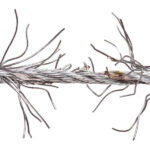
Pooping Unicorns in Paris: a Solstice Prayer
December 21, 2015
El problema del dolor en el yoga
March 9, 2016This essay first appeared in Yoga International: thank you to Kat Heagburg for editorial help.
____
You’ve probably heard a number of translations for the haṭha part of haṭhayoga.
“Forceful” is commonly cited. Others prefer a more esoteric take: they say that ha- and -ṭha stand for “sun and moon,” or “inhale and exhale.” They propose that practice is aimed at the integration of opposing forces.
According to yoga scholar Jason Birch, the esoteric translation is probably a later addition to the early literature of haṭhayoga. “Forceful” is the older meaning.
But what kind of “force” were the originators of haṭhayoga describing?
Birch writes that the hugely influential 19th century Sanskritist Monier Monier-Williams, along with other European Indologists of his era, “confounded haṭhayoga with extreme practices of asceticism (tapas) that appear in the purāṇas” or epic literature. Together, they put forward the notion that haṭha implied the force of violent exertion or self-mortification.
Traces of this meaning elide with the “no pain, no gain” heroism of the modern fitness era—and with the notion of moving, or being pushed by teachers, toward the “edge” of tolerance—usually at the end-range of a joint’s motion. The edge is typically viewed as a potential threshold of revelation, perhaps because its shadow is the threshold of injury.
But as Birch carefully points out, the consistent refrain of the early haṭhayoga manuals is that if practices are done śanaiḥ, śanaiḥ —”gently, gently”— spiritual awakening will inevitably occur. In other words, with enough gentleness in your practice, you’d be forced to wake up.
In fact, as Birch writes, “The interpretation of haṭhayoga as ‘violent exertion’ is, in effect, refuted by the haṭhapradīpikā (1.15), which includes exertion (prayasā) as one of the six factors that ruin haṭhayoga.”
Whether they know it or not, many modern practitioners and teachers are starting to flirt with this memory of “gentleness” more and more. Restorative practice is on the rise, and Yoga therapy is becoming a better-defined field. Yoga nidra is gaining popularity, and more practitioners have become aware of the nurturing ethos of Ayurveda. And J. Brown has coined a meme: “Gentle is the New Advanced.”
But not everyone wants to ride the gentle train. Force that drives toward the edge and beyond continues to be a valued currency in the modern yoga project. One reason is the near-complete integration of asana with athletics and body-image anxiety in the global market. But deeper roots lie in the transformative ambivalence of pain psychology, the un-gentleness of early modern yoga history, and the ongoing resonance of austere elements in yoga philosophy.
Basic notes on pain psychology.
It is a counterintuitive fact that pain experienced in the relatively controlled environment of an asana class can be alluring to some practitioners. To the dissociated, it can offer re-embodiment. To the traumatized, it can offer the repetition of sensations within a scenario of greater autonomy. The pain you choose can be better than the pain that is forced upon you; you may be able to adapt to chosen pain with more clarity.
To those who had certain images emblazoned into their childhood brains—like that of the crucifixion, or of Hanuman tearing open his own chest to reveal Ram and Sita — pain might be tangled up with expressions of love or signs of enlightenment. If one was spanked as a child and told that it was for one’s own good, one may associate pain with re-admittance into the good grace of the parent.
Ariel Glucklich, a scholar of the religious use of pain, says that pain can give meaning to suffering that is otherwise difficult to express. Literary scholar Elaine Scarry emphasizes that pain transcends language altogether. It’s little wonder that pain is so easily associated with mystical experience—that mixture of the inexpressible and the silent.
If pain is one of the features of an “adjustment,” it can also become a way in which teachers and students can explore the boundaries of consent and surrender. More darkly, pain given by the hand one trusts might reframe experiences of pain delivered in betrayal. If these dynamics are unconscious, of course, teacher and student may be simply re-enacting familiar scenarios of power or even abuse.
Most responsible teachers today will caution students away from pain. They know it should be left to qualified therapists to help students explore why they might be drawn to pain. They also know they’re treading on dangerous ground if they try to interpret the meaning of pain for anyone but themselves.
Some history.
The roots of modern postural yoga are far from gentle. The early students of T. Krishnamacharya learned their art in the pressure-cooker of a hyper-masculine, anti-colonial physicalist movement. Corporal punishment was a standard mechanism of their training. The goal of waking up through asana practice was wholly subordinated to the goal of performing physical mastery through countless demonstrations that Krishnamacharya himself would later call “propaganda.”
Through my research, I’ve come to believe that this brief and violent era has resonated disproportionately through the globalized yoga body ever since. It takes the forms of performance obsession, a manic drive towards physical mastery, and the persistence of invasive adjustment techniques. A good portion of yoga pedagogy continues to carry the unacknowledged shadow of authoritarian power dynamics that largely sought to shape and discipline children’s bodies according to tense socio-political ideals. The most common—and seemingly benign—expression of this shadow is heard whenever a yoga teacher tells other bodies what they should do.
Every major advancement in global yoga pedagogy over the last fifty years — including but not limited to the therapeutic approaches of T.K.V. Desikachar, Vanda Scaravelli’s spinal-wave theory, Erich Schiffman’s “Freedom Style,” Donna Farhi’s writing on the student-teacher relationship, and the appearance of consent cards for adjustments— has emerged as either a conscious or unconscious reframing or rejection of the methods of the Mysore Palace. However, these developments remain at the fringes of mainstream yoga, which continues to be heavily influenced by the attitudes—if not the precise techniques—of Krishnamacharya’s most famous students from the 1930s.
What are those attitudes? (Two brief points on philosophy.)
Firstly, the body is viewed as the instrument of the inner self’s journey, and a sign of worthy citizenship. It is to be molded, sculpted, softened, cleansed, and purified. It is given progressive sequences, mantras, juices, herbs, purgations, and enemas. It must be continually renovated—and deconstructed—to make the inner self more visible, and the outer citizen more respectable. Pain is often rationalized as an inevitable part of this process:
“Pain is weakness leaving the body.”
“Pain is your guru.”
“Pain is real.”
These three quotes come from the three most influential yoga teachers of the post-60’s globalization period.
Point two can be grasped through the etymology of the word mokṣa: to “loosen,” “release,” or “liberate.” The word arises from millennia of literature that use metaphors of bondage to describe conditioned existence. Is it any wonder that most physical yoga practice emphasizes flexibility through the repetition of end-range motions?
The body can become strong through asana, but the embodied logic of mokṣa may, in the end, value that strength to the extent that it “unknots” the body—from the sinews to the chakras—as the very source of “attachment” to whatever essence needs to be released. This may be one place where the common notion that haṭha implies forceful action obtains its psychological currency.
Stated starkly, these attitudes may seem neither current nor attractive. But they radiate an older wisdom that contemporary fixations upon therapy, healing, and yoga vacations rarely approach:
The body is an ambivalent mystery, bound in time. It connects but separates. It throws off light by burning itself up. It is capable of confusing pain with pleasure under duress. It will become dysfunctional, it will die. It’s not surprising that attempts to improve or sanctify a body you feel might betray you can involve a certain impotent rage.
If pain is measured out by a method, experienced through the perception of consent, and narrativized as a path to realization, it can help some practitioners grapple with the existential strangeness of the body. They will likely continue to crave it.
What remains is for each practitioner to assess what the attraction to force costs over time. And perhaps to explore if and when the lessons of pain exhaust themselves to reveal a hidden memory of gentleness.